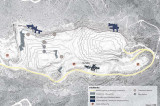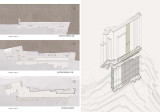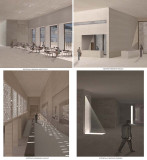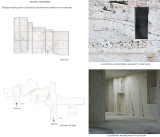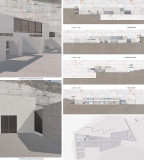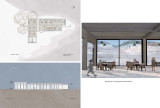Supervisor:
2024
Mount Pentelicus rises to the northeast of Athens and consists of a single ridge stretching from west to east. The presence of white marble within the mountain led to the establishment of ancient and modern quarries. The natural relief of the mountain has been eroded and transformed over time due to continuous extraction of white stone. Observing the relief of Pentelicus served as the starting point for this thesis.
The Dionysus quarry, on the northern side of the mountain, was chosen as the intervention point, being the only operational marble quarry in Pentelicus to date. The violent intrusion of the white quarry landscape into the natural space is evident from a distance, reflecting the impact of modern quarrying processes. The method of surface mining, gradually removing soil for mineral exploitation, creates marble-faced terraces, altering the topography of the area. At the Dionysus quarry, the marble faces, colossal gates to the underground extraction, and additional industrial installations, compose the newly constructed landscape, where marble serves as a vital element in various qualities and sizes.
This thesis aims to reassess the mining landscape through a hypothetical scenario of quarry abandonment. The residual landscape is utilized as the core of analysis and design. Proposed interventions leverage the space's characteristics, placing visitors inside the quarry and creating new uses. Movement within the space, human scale, views, and the materiality of marble define the new framework for understanding the space.
Today's restoration primarily focuses on covering and leveling the excavation voids in combination with vegetation restoration. In contrast, this thesis treats the residual quarry relief as a dynamic space containing a set of relationships and interactions related to the violent quarrying process. Seeking new ways to revitalize the residual landscape beyond restoration limits, as well as reconnecting it to the urban fabric, delineate the design framework of this work.

